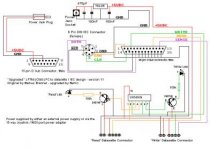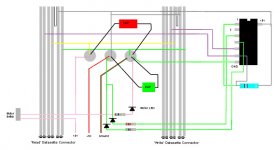Merlin
Experienced Member
Hi,
I thought you guys might like to know about a project I'm working on to produce an updated and upgraded version of Markus Brenner's C64S interface. Markus no longer has the Gerber drawing for his original and recent events have allowed us to improve on his original unit.
An old home made 80s standalone tape-to-tape duplicator was bought by Arkanoid at Lemon64 and he posted photographs. I've been studying these and I think I've managed to reverse engineer it and combine it with Markus' original C64S interface.
The new unit should work in three modes as follows.
1. Standard C64S mode to allow TAP files to be written back to tape from a PC via the parallel port and using programs like MKTAP or TAP2WAV.
2. Downloading of D64 files to a Commodore 1541/71/81 disk drive via a 6 pin DIN IEC interface.
3. Stand-alone tape duplicator mode, to allow 1:1 backup of original tapes with little or no loss of signal quality, using two datasette units.
The unit also incorporates LEDs to indicate data transfer to tape either directly from from the PC or from read / write datasette units; this will be useful to indicate when data download or backup is complete. It has been redesigned to allow for the use of either a cheap external mains power supply for PCs without joystick ports, or to use a separate adapter to connect to Joystick ports for the 5v supply.
The project and schematics are here:-
http://www.amibay.com/viewtopic.php?f=88&t=2742
Comments and suggestions are welcomed and I should be building a prototype unit to test in the next week or so. If anyone is interested in purchasing one of these units as the C64S is no longer made, please let me know either here or at AmiBay.
If there is enough interest, we will get the PCB drawn up in Eagle and look to get some boards professionally made.
I thought you guys might like to know about a project I'm working on to produce an updated and upgraded version of Markus Brenner's C64S interface. Markus no longer has the Gerber drawing for his original and recent events have allowed us to improve on his original unit.
An old home made 80s standalone tape-to-tape duplicator was bought by Arkanoid at Lemon64 and he posted photographs. I've been studying these and I think I've managed to reverse engineer it and combine it with Markus' original C64S interface.
The new unit should work in three modes as follows.
1. Standard C64S mode to allow TAP files to be written back to tape from a PC via the parallel port and using programs like MKTAP or TAP2WAV.
2. Downloading of D64 files to a Commodore 1541/71/81 disk drive via a 6 pin DIN IEC interface.
3. Stand-alone tape duplicator mode, to allow 1:1 backup of original tapes with little or no loss of signal quality, using two datasette units.
The unit also incorporates LEDs to indicate data transfer to tape either directly from from the PC or from read / write datasette units; this will be useful to indicate when data download or backup is complete. It has been redesigned to allow for the use of either a cheap external mains power supply for PCs without joystick ports, or to use a separate adapter to connect to Joystick ports for the 5v supply.
The project and schematics are here:-
http://www.amibay.com/viewtopic.php?f=88&t=2742
Comments and suggestions are welcomed and I should be building a prototype unit to test in the next week or so. If anyone is interested in purchasing one of these units as the C64S is no longer made, please let me know either here or at AmiBay.
If there is enough interest, we will get the PCB drawn up in Eagle and look to get some boards professionally made.




